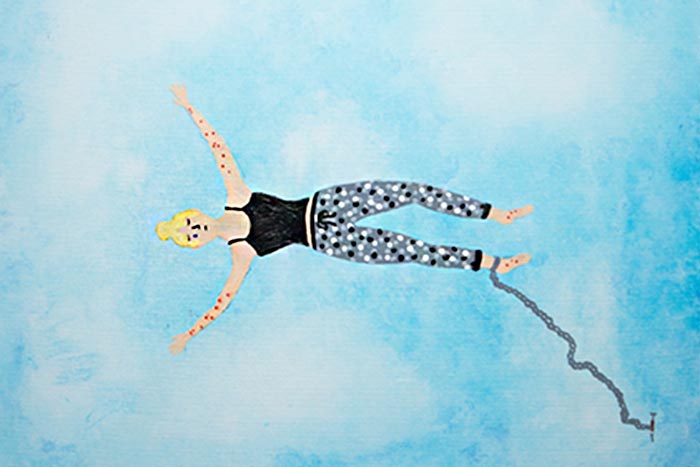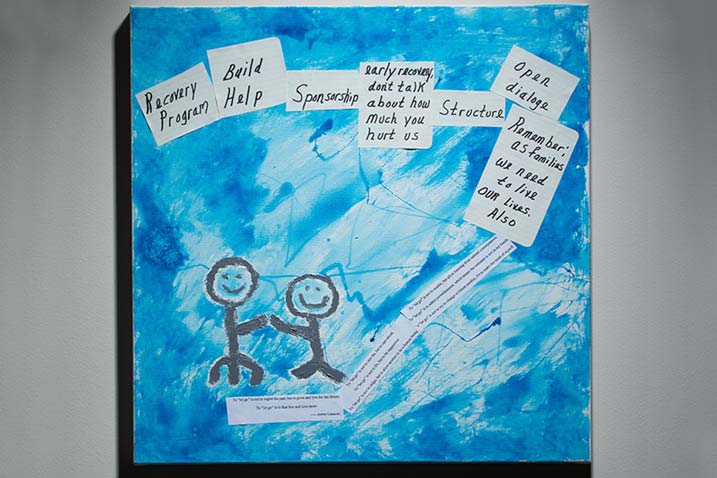Opioid Project
Art and Storytelling Change Perceptions of Opioid Addiction
Through community-based partnerships, The Opioid Project: Changing Perceptions Through Art and Storytelling seeks to increase public awareness and to change perceptions about opioid addiction and the individuals whose lives it affects.
The project was developed by artist Nancy Marks and internist Annie Brewster and has been hosted in many Massachusetts communities. Through a generous philanthropic gift, Hilary S. Connery, MD, PhD, clinical director of McLean’s Division of Alcohol, Drugs, and Addiction partnered with Marks and Brewster to bring the Opioid Project to McLean.
For several years, Dr. Connery has sounded an alarm about the fact that sometimes what looks like an accidental overdose is actually a suicide. If we ignore that reality and the psychiatric illnesses often at the heart of substance use disorders, a solution to the opioid crisis will remain elusive, she argues. “I could explain with data, experience, and logic why we need to think about overdoses this way, but it isn’t effective,” said Dr. Connery. “I thought the message might have more impact if it was communicated on a gut, emotional level through a vehicle like the Opioid Project.”
As part of an art and audio storytelling workshop held at McLean in September 2018, recovery partners—an individual in recovery and a person in their life who has provided support on that journey—processed their experiences by creating art pieces and accompanying artist statements and sharing their personal recovery stories, which were recorded. Dr. Connery along with three pairs, a therapist and her client, a mother and her son, and a mother and her daughter, each participated.
Ava and Nancy
Ava, Nancy’s client

I painted my body floating above the clouds, like I’m flying. This symbolizes the state of being high but no longer enjoying it. It represents the point at which you have been using for so long that you become a viewer of your life, watching it go by, as you continually use different substances, trying to get away from your own reality.
In the painting, I’m wearing the outfit I wore on the last day I used heroin and the first day of my sobriety, which I am continuing in my recovery. There are track marks on my arms and feet, and hanging from my leg is a chain that ties me to the needle. Although I am overlooking my life in this image, I am still dependent on a substance that is tying me down, or flying with me. This painting depicts the transition between rock bottom and resurrection/rebirth. It is in the moment that you are still tied to the substance that has long controlled you, you can see your life for what it really has become.
I hope that people who see this know that you have the choice to detach from the substance, but only once you see your life and your journey for what it truly is. Are you willing to take that step? Are you willing to fly without that crutch?
Listen to Ava tell her story
Nancy, Ava’s therapist

The sparkles represent the draw of drugs, their allure, how hard it is to battle the pull of this shiny object. Inside is a puzzle piece, so hard to figure out, surrounded by the mess of the crinkly paper. Addiction is so messy, there is no one size fits all, no one clear path to treatment. This piece speaks to what a messy issue it is to navigate.
It’s a messy journey, mingled with pain, relapse, sorrow, confusion, while working toward the goal of freedom and transformation, highlighted in yellow and orange to represent the light and clarity that illuminates recovery.
The drama masks show that it is a mixed journey of both joy and sorrow, happy and sad. The words scattered throughout represent the strength and determination it takes to navigate this journey.
Listen to Nancy tell her story
Joe and Diane
Joe, Diane’s son

This painting represents my journey from active addiction, the darkness and bleak shadows on one side…to recovery, represented by the sunlight and the serenity prayer medal on the other side. Somewhere, along the way, I began to break free.
My mother has been there for this whole journey. The pictures of my mom and I walking, with our shadows, show all the times we have felt lost or in limbo. I felt lost and so did my mom. She didn’t know what to do.
Making this painting has helped me feel a whole lot lighter. Addiction makes you feel like a hostage, and by telling this story, and reflecting on my journey, I now feel like a weight has been lifted. I feel free.
Listen to Joe tell his story
Diane, Joe’s mother

My artwork represents my journey with my son, Joseph. I chose the blue background because he loves Michigan State, and because he loves the ocean and the sky—both are eternal like my love for Joe.
The stick figures represent us reaching out to one another. It has been a long and painful journey, but we have come so far. We are joined here by our hands to show that we are united in this journey together.
I put the examples of the journal entries across the top because keeping a journal was so helpful to me in this process.
I also want to help other people who are going through this journey to know that they are not alone, and to share with them some of the steps and lessons that were helpful to me. As you confront the journey of addiction, I hope you will never lose hope. Know that it will get better.
Listen to Diane tell her story
Kelly and Martha
Kelly, Martha’s daughter

My artwork feels very scattered, and that also reflects how my life has felt. It shows many different moments and stages in my recovery journey. I got sober in 1997 and have included my AA medal, reflecting 18 years of sobriety at the time. Since then, there have been times when I have struggled with suicidality, chronic pain, and multiple health conditions. At one point, I was taking 13 prescription medications at a time.
At some point, I learned about Kratom, an herbal remedy that has helped me get off all the other drugs. At first, I thought it was snake oil, but it has truly helped me to reclaim my life. I have incorporated into this painting leaves from plants in my garden, and Kratom tea leaves in the shape of a heart, as well as a passage from Genesis that tells us there are healing gifts for us in the earth for us to use and respect.
At the center of my painting are pictures of my mother, because she has been the center of my world. I wouldn’t have survived without my mother, and now I can take care of her.
Listen to Kelly tell her story
Martha, Kelly’s mother

The painting is divided into a time of “before” and “after” in Kelly’s life and her recovery journey.
The sugar skull represents a dark period in Kelly’s life. The puppy dog wrapped in Christmas tree lights shows the impact on her mind—I wonder, what sober person would wrap a dog in tree lights? The broken knife represents the times I had to use a knife in the door hinge because Kelly was sleep walking and that was the only way I could keep her from going outside, one of my many attempts to keep her safe.
The AA token represents 18 years of sobriety from alcohol, and today, Kelly has 21 years in recovery. The photo of Kelly, with the small dog, and with the tulips, shows the change in Kelly once she was able to stop taking prescription pain relievers. The picture in the middle represents my relief and my joy at having my daughter back from addiction and pain.
The four notes chronicle Kelly’s time on pain prescriptions and her time since she no longer takes opioids. It concludes with the statement that for many years, until late 2014, I was trying to take care of my daughter. Now she takes care of me.
The bold colors in the background represent sunshine, love, and freedom.
Listen to Martha tell her story
Hilary

This is my experience witnessing recovery processes that are common to those in early treatment phases of recovery from substance use disorder and from suicidality. The central gray oval is the acute stabilization phase: I watch people struggle with this limbo state—unable to experience true joy or even momentary pleasure, doubting their identity, purpose, value, ability to connect with others meaningfully, to experience any peace of mind that lasts longer than a millisecond. It is often a very lonely time.
The flaming black hole represents the seductive appeal of both relapse and escape through suicide. The icon of St. Raphael, archangel of medical healing, is placed at the junction of the gray zone and black hole, in part because this is where we clinicians first meet a person—late in their agony. The doors on either side of the gray zone represent the choices open to people at all points of the journey. One leads back to the black hole, and one leads to freedom (sky).
The left door reads, “Said nowhow on.” This reflects the first and last line of the Samuel Beckett short story, “Worstward Ho.” It is a magnificent depiction of the primal thought processes of a person in debilitating psychic pain. The life drive intrudes reliably, which is at once miraculous and necessary for hope. The right door reads, “Cor ad cor loquitur,” Latin for “heart speaks to heart.” It is one of my favorite expressions of what cannot be articulated but is always involved in healing.
Four Celtic spirals in the sky are the enduring traces of four wonderful people I worked with who tried mightily but lost their lives to despair.



